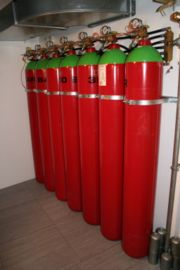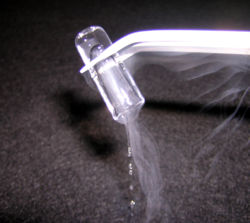Argon
2008/9 Schools Wikipedia Selection. Related subjects: Chemical elements
|
|||||||||||||||||||||||||||||||||||||||||||||||||
| General | |||||||||||||||||||||||||||||||||||||||||||||||||
|---|---|---|---|---|---|---|---|---|---|---|---|---|---|---|---|---|---|---|---|---|---|---|---|---|---|---|---|---|---|---|---|---|---|---|---|---|---|---|---|---|---|---|---|---|---|---|---|---|---|
| Name, symbol, number | argon, Ar, 18 | ||||||||||||||||||||||||||||||||||||||||||||||||
| Chemical series | noble gases | ||||||||||||||||||||||||||||||||||||||||||||||||
| Group, period, block | 18, 3, p | ||||||||||||||||||||||||||||||||||||||||||||||||
| Appearance | colorless |
||||||||||||||||||||||||||||||||||||||||||||||||
| Standard atomic weight | 39.948 (1) g·mol−1 | ||||||||||||||||||||||||||||||||||||||||||||||||
| Electron configuration | [Ne] 3s2 3p6 | ||||||||||||||||||||||||||||||||||||||||||||||||
| Electrons per shell | 2, 8, 8 | ||||||||||||||||||||||||||||||||||||||||||||||||
| Physical properties | |||||||||||||||||||||||||||||||||||||||||||||||||
| Phase | gas (At room temperature) | ||||||||||||||||||||||||||||||||||||||||||||||||
| Density | (0 °C, 101.325 kPa) 1.784 g/L |
||||||||||||||||||||||||||||||||||||||||||||||||
| Melting point | 83.80 K (−189.35 ° C, −308.83 ° F) |
||||||||||||||||||||||||||||||||||||||||||||||||
| Boiling point | 87.30 K (−185.85 ° C, −302.53 ° F) |
||||||||||||||||||||||||||||||||||||||||||||||||
| Triple point | 83.8058 K (-189° C), 69 kPa | ||||||||||||||||||||||||||||||||||||||||||||||||
| Critical point | 150.87 K, 4.898 MPa | ||||||||||||||||||||||||||||||||||||||||||||||||
| Heat of fusion | 1.18 kJ·mol−1 | ||||||||||||||||||||||||||||||||||||||||||||||||
| Heat of vaporization | 6.43 kJ·mol−1 | ||||||||||||||||||||||||||||||||||||||||||||||||
| Specific heat capacity | (25 °C) 20.786 J·mol−1·K−1 | ||||||||||||||||||||||||||||||||||||||||||||||||
|
|||||||||||||||||||||||||||||||||||||||||||||||||
| Atomic properties | |||||||||||||||||||||||||||||||||||||||||||||||||
| Crystal structure | cubic face centered | ||||||||||||||||||||||||||||||||||||||||||||||||
| Oxidation states | 0 | ||||||||||||||||||||||||||||||||||||||||||||||||
| Electronegativity | no data (Pauling scale) | ||||||||||||||||||||||||||||||||||||||||||||||||
| Ionization energies ( more) |
1st: 1520.6 kJ·mol−1 | ||||||||||||||||||||||||||||||||||||||||||||||||
| 2nd: 2665.8 kJ·mol−1 | |||||||||||||||||||||||||||||||||||||||||||||||||
| 3rd: 3931 kJ·mol−1 | |||||||||||||||||||||||||||||||||||||||||||||||||
| Atomic radius | 71 pm | ||||||||||||||||||||||||||||||||||||||||||||||||
| Atomic radius (calc.) | 71 pm | ||||||||||||||||||||||||||||||||||||||||||||||||
| Covalent radius | 97 pm | ||||||||||||||||||||||||||||||||||||||||||||||||
| Van der Waals radius | 188 pm | ||||||||||||||||||||||||||||||||||||||||||||||||
| Miscellaneous | |||||||||||||||||||||||||||||||||||||||||||||||||
| Magnetic ordering | nonmagnetic | ||||||||||||||||||||||||||||||||||||||||||||||||
| Thermal conductivity | (300 K) 17.72x10-3 W·m−1·K−1 | ||||||||||||||||||||||||||||||||||||||||||||||||
| Speed of sound | (gas, 27 °C) 323 m/s | ||||||||||||||||||||||||||||||||||||||||||||||||
| CAS registry number | 7440–37–1 | ||||||||||||||||||||||||||||||||||||||||||||||||
| Selected isotopes | |||||||||||||||||||||||||||||||||||||||||||||||||
|
|||||||||||||||||||||||||||||||||||||||||||||||||
| References | |||||||||||||||||||||||||||||||||||||||||||||||||
Argon (pronounced /ˈɑrgɒn/) is a chemical element designated by the symbol Ar. Argon has atomic number 18 and is the third element in group 18 of the periodic table (noble gases). Argon is present in the Earth's atmosphere at 0.93%, making it the most abundant noble gas on Earth. Its full outer shell makes argon stable and resistant to bonding with other elements. Its triple point temperature of 83.8058 K is a defining fixed point in the International Temperature Scale of 1990.
Characteristics
Argon has approximately the same solubility in water as oxygen gas and is 2.5 times more soluble in water than nitrogen gas. Argon is colorless, odorless, tasteless and nontoxic in both its liquid and gaseous forms. Argon is inert under most conditions and forms no confirmed stable compounds at room temperature.
Although argon is a noble gas, it has been found to have the capability of forming some compounds. For example, the creation of argon hydrofluoride (HArF), a metastable compound of argon with fluorine and hydrogen, was reported by researchers at the University of Helsinki in 2000. Although the neutral ground-state chemical compounds of argon are presently limited to HArF, argon can form clathrates with water when atoms of it are trapped in a lattice of the water molecules. Also argon-containing ions and excited state complexes, such as ArH+ and ArF, respectively, are known to exist. Theoretical calculations have shown several argon compounds that should be stable but for which no synthesis routes are currently known.
History
Argon ( Greek meaning "lazy one," in reference to its chemical inactivity) was suspected to be present in air by Henry Cavendish in 1785 but was not discovered until 1894 by Lord Rayleigh and Sir William Ramsay in Scotland in an experiment in which they removed all of the oxygen and nitrogen from a sample of air. Argon was also encountered in 1882 through independent research of H.F. Newall and W.N. Hartley. Each observed new lines in the colour spectrum of air but were unable to identify the element responsible for the lines. Argon became the first member of the noble gases to be discovered. The symbol for argon is now Ar, but up until 1957 it was A.
Occurrence
Argon constitutes 0.934% by volume and 1.29% by mass of the Earth's atmosphere, and air is the primary raw material used by industry to produce purified argon products. Argon is isolated from air by fractionation, most commonly by cryogenic fractional distillation, a process that also produces purified nitrogen, oxygen, neon, krypton and xenon.
The Martian atmosphere in contrast contains 1.6% of argon-40 and 5 ppm of argon-36. The Mariner spaceprobe fly-by of the planet Mercury in 1973 found that Mercury has a very thin atmosphere with 70% argon, believed to result from releases of the gas as a decay product from radioactive materials on the planet. In 2005, the Huygens probe also discovered the presence of argon-40 on Titan, the largest moon of Saturn.
Isotopes
The main isotopes of argon found on Earth are 40Ar (99.6%), 36Ar (0.34%), and 38Ar (0.06%). Naturally occurring 40K with a half-life of 1.25×109 years, decays to stable 40Ar (11.2%) by electron capture and positron emission, and also to stable 40Ca (88.8%) via beta decay. These properties and ratios are used to determine the age of rocks.
In the Earth's atmosphere, 39Ar is made by cosmic ray activity, primarily with 40Ar. In the subsurface environment, it is also produced through neutron capture by 39K or alpha emission by calcium. 37Ar is created from the decay of 40Ca as a result of subsurface nuclear explosions. It has a half-life of 35 days.
Compounds
Argon’s complete octet of electrons indicates full s and p subshells. This full outer energy level makes argon very stable and extremely resistant to bonding with other elements. Before 1962, argon and the other noble gases were considered to be chemically inert and unable to form compounds; however, compounds of the heavier noble gases have since been synthesized. In August 2000, the first argon compounds were formed by researchers at the University of Helsinki. By shining ultraviolet light onto frozen argon containing a small amount of hydrogen fluoride, argon hydrofluoride (HArF) was formed. It is stable up to 40 kelvins (−233 ° C).
The discovery of argon difluoride (ArF2) was announced in 2003. But this is unconfirmed and most probably incorrect.
Production
Industrial
In radioactive decays
Argon-40, the most abundant isotope of argon, is produced by the decay of potassium-40 with a half-life of 1.26e+9 years by electron capture or positron emission.
Potassium-argon dating
Applications

There are several different reasons why argon is used in particular applications:
- An inert gas is needed. In particular, argon is the cheapest alternative when diatomic nitrogen is not sufficiently inert.
- Low thermal conductivity is required.
- The electronic properties (ionization and/or the emission spectrum) are necessary.
Other noble gases would probably work as well in most of these applications, but argon is by far the cheapest. Argon is inexpensive since it is a byproduct of the production of liquid oxygen and liquid nitrogen, both of which are used on a large industrial scale. The other noble gases (except helium) are produced this way as well, but argon is the most plentiful since it has the highest concentration in the atmosphere. The bulk of argon applications arise simply because it is inert and relatively cheap. Argon is used:
- As a fill gas in incandescent lighting, because argon will not react with the filament of light bulbs even at high temperatures.
- As an inert gas shield in many forms of welding, including metal inert gas welding and tungsten inert gas welding. For metal inert gas welding Argon is often mixed with CO2.
- For extinguishing fires where damage to equipment is to be avoided (see photo).
- As the gas of choice for the plasma used in ICP spectroscopy.
- As a non-reactive blanket in the processing of titanium and other reactive elements.
- As a protective atmosphere for growing silicon and germanium crystals, and in partial pressure heat treat furnaces.
- By museum conservators to protect old materials or documents, which are prone to gradual oxidation in the presence of air.
- To keep open bottles of wine from oxidizing, and in a number of dispensing units and keeper cap systems.
- In winemaking to top off barrels, displacing oxygen and thus preventing the wine from turning to vinegar during the aging process.
- In the pharmaceutical industry to top off bottles of intravenous drug preparations (for example intravenous paracetamol), again displacing oxygen and therefore prolonging the drug's shelf-life.
- Used to cool the seeker head of the US Air Force version of the AIM-9 Sidewinder missile. The gas is stored at high pressure, and the expansion of the gas cools the seeker.
- As an atmosphere in graphite electric furnaces, to keep graphite from oxidizing.
The next most common reason for using argon is its low thermal conductivity. It is used for thermal insulation in energy efficient windows. Argon is also used in technical scuba diving to inflate a dry suit, because it is inert and has low thermal conductivity.
Argon is also used for the specific way it ionizes and emits light. It is used in plasma globes and calorimetry in experimental particle physics. Blue argon lasers are used in surgery to weld arteries, destroy tumors, and to correct eye defects. In microelectronics, argon ions are used for sputtering.
Finally, there are a number of miscellaneous uses. Argon-39, with a half life of 269 years, has been used for a number of applications, primarily ice core and ground water dating. The argon-40/potassium-40 ratio is used in dating igneous rocks.
Cryosurgery procedures such as cryoablation use liquified argon to destroy cancer cells. In surgery it is used in a procedure called "argon enhanced coagulation" which is a form of argon plasma beam electrosurgery. The procedure carries a risk of producing gas embolism in the patient and has resulted in the death of one person via this type of accident.
Potential hazards
Although argon is non-toxic, it does not satisfy the body's need for oxygen and is a simple asphyxiant. People have suffocated by breathing argon by mistake.


